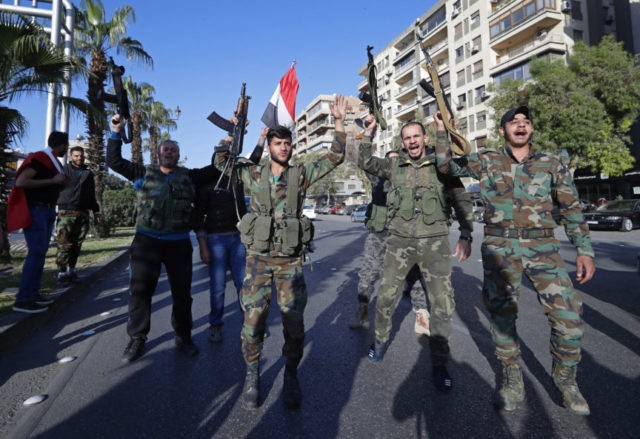Building on his recapture of the Eastern Ghouta suburb after a long and bloody siege that ended with an alleged chemical weapons attack, Syrian dictator Bashar Assad on Tuesday began the final battle for control of Damascus with artillery strikes on the last rebel positions near the city.
Reuters reports the Syrian military is moving on Yarmouk, formerly the location of Syria’s largest camp for Palestinian refugees. The camp was captured by the Islamic State (ISIS) years ago, prompting most of the residents to flee.
A commander aligned with the Syrian government—presumably an officer in one of the militia forces allied with Assad—told Reuters the operation in Yarmouk will target the remaining ISIS fighters, plus Nusra Front militants aligned with al-Qaeda. The commander claimed steps are being taken to evacuate civilians from the area.
“A recent uptick in violence, including exchanges of rocket fire have been reported. According to the recent reports, the Syrian Army has sent its 9th Armored Division, Tiger Forces and Palestinian units that support Assad to help retake Yarmouk,” the Jerusalem Post reported on Monday. The Palestinian Liberation Organization issued a “last warning” to rebel forces in Yarmouk giving them only a few days to leave before a ground operation begins.
According to the Jerusalem Post, there are about 18,000 Palestinians still living in Yarmouk, under conditions “bordering on starvation.” Some of those who fled found asylum in Europe, most famously including musician Aeham Ahmad, who became a YouTube sensation as “The Pianist of Yarmouk” by performing for children in the besieged city, until ISIS decided to ban music and set fire to his piano.
Moving further out from Damascus, Reuters’ contact claimed that Russia is working on surrender agreements for the largest remaining rebel groups. Turkey’s state-run Andalou Agency sees Assad rolling through Homs province on his momentum from recapturing Eastern Ghouta:
According to information obtained from Anadolu Agency reporters in Homs, within the past three days, regime forces have managed to capture the villages of Wadi al-Hubbiya, Wadi al-Qurbat, Ard al- Jassiya, Ard Kabir al-Sheyha, Zahrat Jebabi and Zahrat Jassiya.
During the course of the regime’s ground operations, the Teblise and Rastan districts of Homs, Deir Ful, Camp Malluk, Musrefiya, Zarafani and Tirmala—all of which are home to large civilian populations—were targeted by regime warplanes, rockets and gunfire.
Local sources say the regime’s main objective is to secure the Salamiya highway linking Aleppo to northern Homs, after which it hopes to seize a 600-square-kilometer area currently held by the opposition.
The final orders of business for Assad would be northwestern Syria, which Turkey is currently invading to fight Kurdish groups they consider terrorist allies of the Kurdish separatists on their side of the border, and eastern Syria, where Iran reportedly plans to help the Syrian military defeat Kurdish and Arab militias supported by the United States. Iran lumps all Syrian rebel forces together as “takfiri” terrorists, meaning false Muslims who perpetrate atrocities to defame Islam.
Institute for the Study of War analyst Chris Kozak told Canada’s CBC News on Tuesday that Assad’s recent victories are the fruit of his brutal “siege and starve” strategy:
Bombing raids destroy hospitals, mosques and markets, making existence in opposition-held regions untenable. The tactic involves fighters cordoning off opposition-held terrain and proceeding “to make life inside that terrain miserable” through a combination of sieges, cutting off food and medical supplies, waging airstrikes and ground attacks, “and keeping the pressure on those pockets until life becomes so unsustainable that people would agree to a reconciliation deal or evacuation,” he said.
“There’s a method to the brutality,” Kozak said. “The Syrian Arab Army has been trying to avoid these painful, urban block-by-block fights, and instead they’re willing to be patient and to starve out these populations … until they cannot function.”
Other analysts quoted by CBC credited Assad’s ruthless focus on winning an existential battle for power, and probably his very life, while Western forces spent years searching for reliable non-terrorist allies in Syria and revising or refusing to define their ultimate objectives.
Another tool in Assad’s inventory is forced relocation, moving large populations across Syria or driving them out of the country entirely in a strategy that effectively weaponizes his own civilians. To this day, the Syrian government’s agreements with rebel forces almost always involve relocation of both fighters and surrounding non-combatants, constantly reshuffling the deck in conflicted areas until Assad draws a winning hand.
If operations in Yarmouk proceed as planned, Assad would regain full control of Damascus for the first time since 2012.

COMMENTS
Please let us know if you're having issues with commenting.